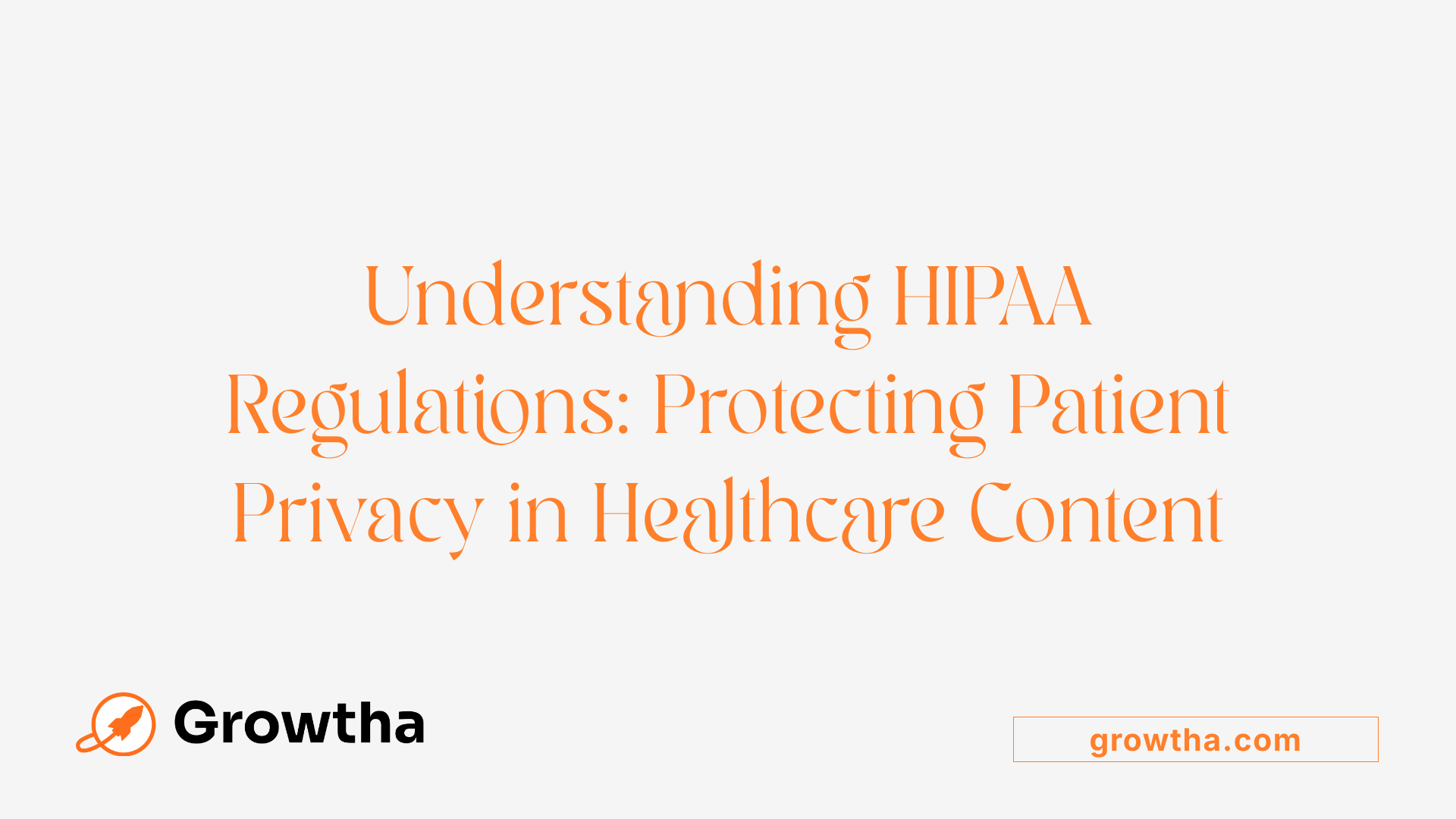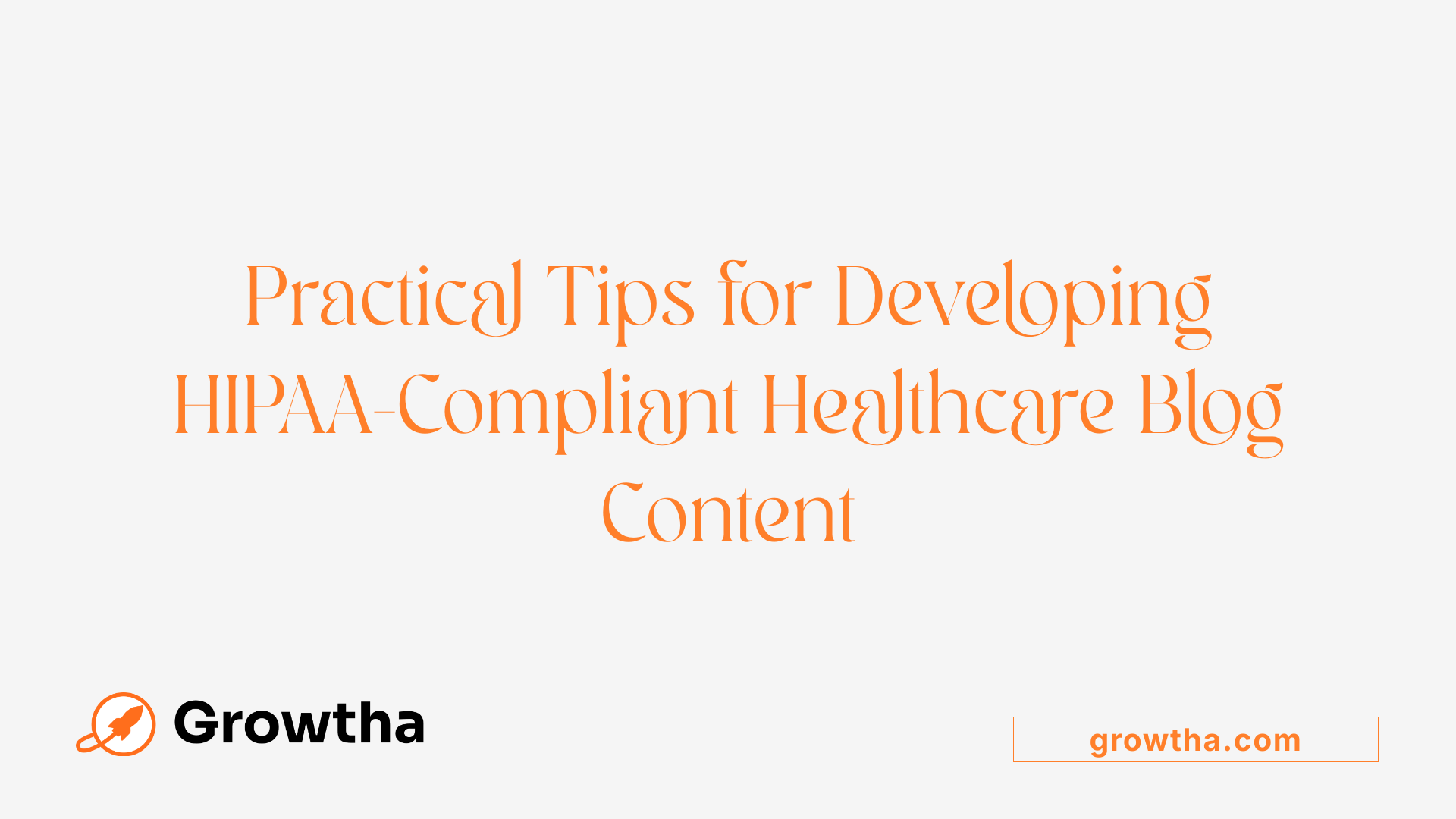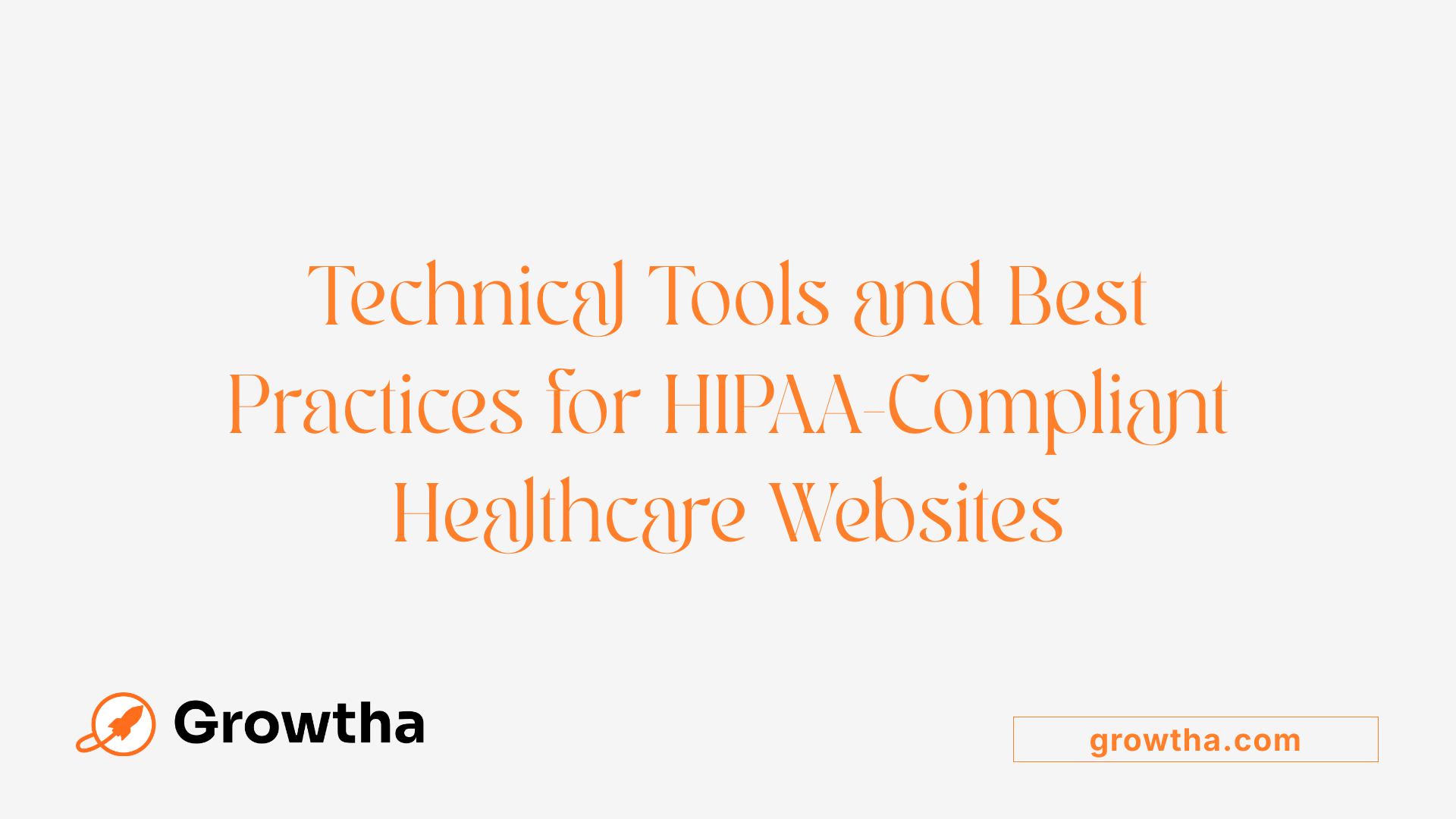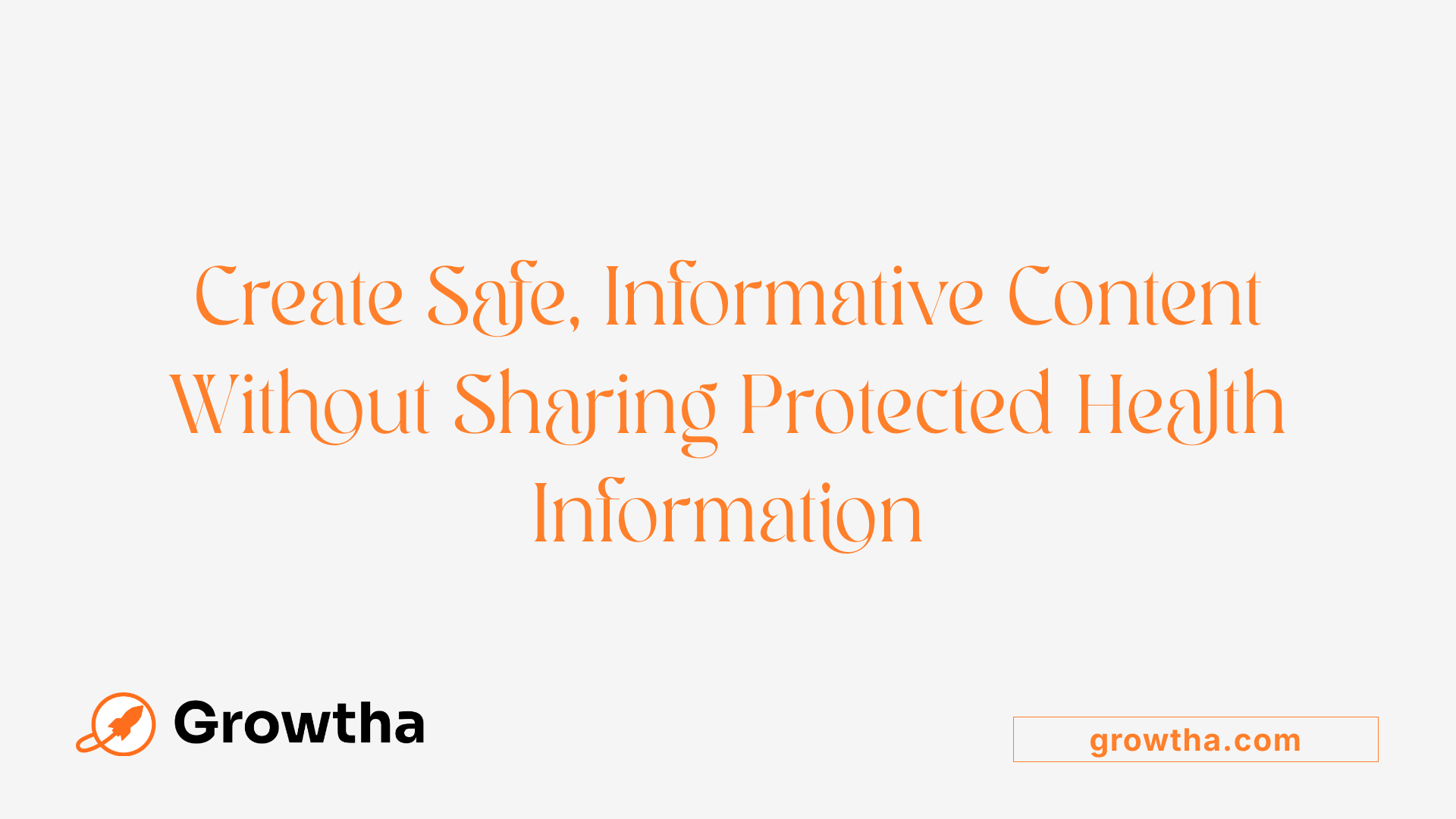How to Write HIPAA-Compliant Blog Content
Ensuring Privacy and Compliance in Medical Blogging


How to Write HIPAA-Compliant Blog Content
Understanding HIPAA and Its Impact on Healthcare Content
Creating compelling healthcare blogs that educate and engage patients while adhering to HIPAA regulations is essential for maintaining trust and protecting patient privacy. This article explores best practices, legal considerations, and technological strategies to ensure your healthcare blog remains compliant, secure, and valuable.
Foundations of HIPAA in Healthcare Content Creation

Overview of HIPAA regulations and their relevance to healthcare blogging
HIPAA, or the Health Insurance Portability and Accountability Act, is a crucial law in the United States that protects sensitive patient health information. This regulation impacts how healthcare providers and organizations create and share digital content, including blogs, to ensure patient privacy remains intact. When developing healthcare content, it’s essential to understand which information qualifies as Protected Health Information (PHI) and to avoid sharing any details that could directly or indirectly identify a patient.
Blogging about medical conditions, health tips, or wellness advice is common in healthcare marketing. However, it must comply with HIPAA’s standards by not including any identifiable patient data unless explicit consent is obtained. Sensitive data such as names, dates of birth, social security numbers, or any other identifiers are off-limits unless the patient has authorized their use.
Main HIPAA rules: Privacy Rule, Security Rule, Breach Notification Rule, Enforcement Rule
HIPAA encompasses four primary rules that healthcare marketers must adhere to:
| Rule | Description | Focus Area |
|---|---|---|
| Privacy Rule | Establishes standards to protect individuals' medical records and personal health info | Confidentiality and patient rights |
| Security Rule | Sets standards for safeguarding electronic PHI, including administrative, technical, and physical safeguards | Data security and integrity |
| Breach Notification Rule | Requires notifying patients and authorities within 60 days of a data breach | Incident response and transparency |
| Enforcement Rule | Defines penalties for violations, including fines and corrective actions | Compliance oversight |
These rules collectively aim to ensure the confidentiality, integrity, and security of patient information while enabling proper use for treatment and health management.
Definition of PHI (Protected Health Information) and types of data covered
PHI includes any individually identifiable health information in any media, whether electronic, paper, or oral. It covers a broad spectrum of data, such as:
- Names
- Social Security numbers
- Phone numbers
- Addresses
- Medical record numbers
- Biometric identifiers
- Health insurance information
The law restricts how this data is collected, used, shared, and disclosed. In the context of healthcare marketing, organizations must handle PHI carefully, often requiring explicit patient authorization before any use in promotional materials or testimonials.
Are there educational resources for healthcare providers on HIPAA content standards?
Yes, numerous resources are available to help healthcare professionals understand and implement HIPAA regulations effectively. The U.S. Department of Health and Human Services (HHS) offers comprehensive training materials, including guides and online modules that cover all facets of HIPAA, including privacy, security, and breach notification rules. The Centers for Medicare & Medicaid Services (CMS) provides specific resources like "HIPAA Basics for Providers," which is tailored to practical applications in medical practice.
Furthermore, the Office for Civil Rights (OCR) maintains a robust website with FAQs, guidance documents, and technical assistance programs. These educational tools are designed to ensure healthcare providers thoroughly understand their responsibilities and stay compliant with evolving regulations.
What legal considerations are involved in creating HIPAA-compliant healthcare marketing content?
Creating compliant marketing content involves balancing informative outreach with privacy protection. First, explicit, written patient consent must be obtained before using their PHI in any targeted marketing efforts. Marketing activities should avoid disclosing identifiable health information publicly, whether in blog posts, emails, or social media.
Utilizing secure, encrypted communication platforms and signing Business Associate Agreements (BAAs) with third-party vendors handling PHI are essential steps. Organizations must also include opt-out options in all communications, allowing patients to unsubscribe easily.
Special care is necessary when sharing testimonials or patient success stories. These require separate, clear consent and should be anonymized if possible. Staff training on legal standards, regular policy reviews, and vigilant monitoring help mitigate the risk of violations and penalties, which can reach millions of dollars.
What are best practices for maintaining patient privacy and confidentiality in healthcare blog posts?
Ensuring privacy in blog content involves several strategic practices. The primary rule is anonymization; never include any specific details that can identify a patient unless obtained through explicit consent. When using patient stories or images, secure written permission, outlining exactly how the content will be used.
Healthcare staff involved in content creation should undergo HIPAA privacy and security training. Implementing strict content review procedures helps prevent accidental disclosures.
Additionally, organizations must use secure, HIPAA-compliant tools for digital communication, such as secure file sharing platforms and encrypted email services. Regular audits, data security policies, and proper staff education create a culture of privacy awareness. All content editing processes should follow a structured approval workflow to maintain compliance.
How can healthcare providers responsibly respond to online reviews while maintaining HIPAA compliance?
Responding to online reviews requires tact and adherence to privacy laws. Providers should avoid referencing any specific patient information, diagnosis, or treatment details. Instead, responses should be generic, empathetic, and aim to maintain professionalism.
It’s advisable to thank reviewers, express concern for their experience, and invite them to contact the office privately for further discussion. For example, a response might say, "We appreciate your feedback and take your concerns seriously. Please contact our office directly so we can address this matter personally."
Training staff about HIPAA-compliant social media practices ensures that responses do not inadvertently disclose protected information. When necessary, direct conversations offline, providing contact details for private communication, further reducing risk.
What strategies can healthcare marketers use to ensure their website and blog content are HIPAA compliant?
Maintaining HIPAA compliance on healthcare websites hinges on implementing appropriate technical and administrative safeguards. Only parts of the site that handle PHI—such as online appointment forms, patient portals, and payment systems—must meet strict security standards.
Using secure hosting providers that offer encryption, firewalls, and regular security audits is fundamental. SSL certificates (HTTPS) encrypt data transmitted between the user and the server, preventing interception.
For data collection tools like forms or chatbots, select HIPAA-compliant solutions and sign BAAs with vendors such as Paubox or Jotform. Role-based access controls limit who can view sensitive data, and multi-factor authentication adds an extra layer of security.
Staff should be trained routinely on privacy policies, and comprehensive policies should govern data handling, storage, and disposal. Regular risk assessments further identify vulnerabilities, ensuring ongoing compliance.
By focusing content creation on general health topics—such as blog articles on wellness, health tips, or educational videos—practices can engage audiences without risking privacy breaches.
| Aspect | Best Practice | Additional Details |
|---|---|---|
| Content Focus | Use general topics, avoid PHI | Educational materials like health tips, videos |
| Data Collection | Use HIPAA-compliant forms with encryption | Secure forms for scheduling, questionnaires |
| Platform Usage | Sign BAAs for third-party tools | Secure chat, messaging apps |
| Website Security | Implement SSL, role-based access, regular audits | Protect sensitive sections and forms |
| Staff Training | Conduct privacy and security training | Ongoing education on HIPAA standards |
By systematically applying these measures, healthcare providers can create informative, engaging, and fully HIPAA-compliant digital content that respects patient privacy while advancing educational and marketing goals.
Creating HIPAA-Compliant Blog Content: Practical Strategies and Tools

How can healthcare providers create HIPAA-compliant blog content?
Creating blog content that aligns with HIPAA regulations is crucial for healthcare providers aiming to educate and engage patients without risking privacy breaches. The core principle is to avoid sharing any protected health information (PHI) or identifiable patient details without explicit, written consent.
One effective strategy is to focus on educational material related to general health topics, preventive care, and wellness tips. These pieces do not involve specific patient cases or any information that could identify individuals. For example, articles about managing common conditions like hypertension or tips for healthy living are safe to publish.
When it comes to patient success stories or testimonials, obtaining written authorization is paramount. If these stories include photos or specific details, consent forms should be included with clear information about the intended use. Alternatively, anonymized or fictionalized stories can be used to share positive outcomes without compromising privacy.
Implementing secure practices in content management also plays a critical role. This includes encrypting digital content, using secure web hosting, and maintaining strict access controls to prevent unauthorized data access. Staff involved in content creation and management should receive regular HIPAA training, with a focus on marketing and privacy rules.
Documentation is another pillar of compliance. Healthcare organizations should document all patient authorizations, consent forms, and policies related to HIPAA compliance. Regular audits of published content and internal procedures help to identify potential risks and ensure ongoing adherence.
Consulting with HIPAA compliance experts or legal advisors can provide tailored guidance. Continual staff education, along with using compliant content management tools—such as secure CMS platforms—ensures that the organization's blog remains both informative and compliant.
By following these practices, healthcare providers can develop valuable, compliant content that enhances patient education and trust while safeguarding privacy.
Technical Measures for Ensuring HIPAA Compliance in Healthcare Blogs

What technical tools and methods ensure HIPAA compliance in website content?
Securing healthcare websites and blogs involves a variety of technical tools and best practices. Encryption is fundamental: SSL/TLS certificates encrypt data transmitted between users and the website, protecting sensitive information from interception. Data stored on servers should also be encrypted, especially when handling Protected Health Information (PHI).
Hosting platforms must meet HIPAA standards, providing secure environments with access controls, audit logs, and physical security safeguards. For forms collecting PHI, using HIPAA-compliant plugins and third-party tools such as secure forms, encrypted messaging platforms, and HIPAA-compliant chatbots is essential.
Implementing role-based access controls (RBAC) limits data access to authorized staff only. Multi-factor authentication (MFA) adds an extra layer of security by verifying user identities before permitting access.
Regular security audits, vulnerability scans, and monitoring help identify and mitigate potential risks proactively. Proper data disposal methods, such as secure digital wiping or shredding, should be implemented when PHI is no longer needed.
All these measures work together to create a multilayered security framework that helps prevent data breaches and unauthorized disclosures, ensuring compliance with HIPAA regulations.
Are there specific hosting and integration practices to keep healthcare blogs HIPAA compliant?
Yes, maintaining HIPAA compliance in healthcare blogs requires careful selection of hosting and integration practices. First, choose hosting providers experienced in HIPAA-compliant environments. These providers should offer encrypted servers, regular security updates, and compliance with standards such as SOC 2 and ISO 27001.
SSL certificates (HTTPS) are vital for encrypting data during transmission, preventing eavesdropping or tampering.
Any third-party tools, such as contact forms, appointment schedulers, or messaging platforms integrated into the website, must be HIPAA compliant. This includes signing Business Associate Agreements (BAAs), which legally bind vendors to safeguard PHI.
Proper segmentation of content is also important. General informational pages like practice hours or doctor bios should be separated from pages that handle PHI, such as online forms or patient portals.
Regular backups of data, restricted access guided by RBAC, and physical safeguards for servers or data centers are additional best practices. Collaborating with experienced vendors and conducting periodic security assessments form the backbone of ongoing HIPAA compliance.
By following these practices, healthcare providers can ensure that their blogs and websites uphold the strict privacy and security standards required by HIPAA.
Developing Secure and Educational Content Without PHI

What types of healthcare content can be published without risking HIPAA violations?
Healthcare marketing and educational materials can be both informative and compliant when they focus on general health information that does not involve any Protected Health Information (PHI). This includes a broad range of content aimed at educating the public about health topics without referencing individual patients or their specific medical details.
Typical examples encompass general health tips, preventive care advice, wellness strategies, explanations of common medical conditions, and lifestyle modifications. These topics are valuable because they inform the community while avoiding the disclosure or use of any identifiable patient data.
In addition to articles, videos, and infographics about common health issues, healthcare organizations can leverage stories and case studies that are intentionally anonymized. For instance, fictitious storytelling or composite case studies, which merge multiple patient scenarios into a single, non-identifiable narrative, help illustrate medical concepts without breaching confidentiality.
Aggregating data from multiple cases or presenting statistics at a population level also minimizes the risk of revealing individual identities. Utilizing secondary data sources—such as published research or publicly available health statistics—further enhances privacy protection.
Disclaimers and confidentiality notices are crucial in these materials. Clearly stating that any stories are fictional, anonymized, or aggregated assures the audience and helps maintain transparency.
How can storytelling and data aggregation help maintain privacy?
Fictitious stories and simulated case scenarios serve as effective teaching tools, enabling providers to illustrate medical principles or patient journeys without any real patient reference. By deliberately creating scenarios that resemble common clinical situations but do not correspond to specific individuals, organizations can avoid inadvertent disclosures.
Aggregating cases, such as presenting statistics on disease prevalence or health behaviors in large populations, is another privacy-safe method. These approaches rely on summarized data that cannot be traced back to any individual, thus aligning with HIPAA’s requirements.
Using secondary data sources like research publications or government reports ensures that content reflects broad trends rather than specific, identifiable patient information.
What role do disclaimers and confidentiality notices play?
Including disclaimers that clarify the content is fictional or based on aggregated data builds trust and emphasizes privacy. Notices stating that any stories are composites or anonymized help reinforce the organization’s commitment to confidentiality.
Confidentiality notices should explicitly mention that no patient-identifiable information is included in the content, and that all narratives are crafted for educational purposes only.
Creating valuable, privacy-safe health content
Producing meaningful health content without PHI involves focusing on topics that benefit the wider community. Health organizations should aim to generate content that is accurate, engaging, and easy to understand.
Topics like healthy living tips, nutrition advice, exercise routines, mental health awareness, and explanations of common health conditions are well suited for public dissemination.
Visual content such as infographics on preventive care, charts showing disease rates in populations, and instructional videos on lifestyle changes are popular and easy to share.
Moreover, organizations can develop interactive tools or quizzes that do not collect personal data, further engaging users while protecting their privacy.
Overall, creating HIPAA-safe educational content hinges on avoiding specific patient details, employing anonymization techniques, and transparently communicating that stories are fictional or aggregated. This approach not only ensures regulatory compliance but also fosters trust with the audience.
| Content Type | Suitable Examples | Privacy Safeguards |
|---|---|---|
| Articles | General health tips, disease explanations | Avoid patient specifics, anonymize sources |
| Videos | How-to guides, wellness advice | Use stock footage, avoid showing patients |
| Infographics | Preventive care stats, lifestyle tips | Present aggregated data, not individual data |
| Stories | Fictional patient narratives, composite cases | Clearly label as fictional or anonymized |
| Interactive content | Quizzes, calculators | Do not collect PHI, embed privacy notices |
By emphasizing privacy protections and focusing on broad, health-promoting topics, healthcare providers can create engaging, compliant educational content that benefits the community while safeguarding patient confidentiality.
Maintaining Compliance While Engaging Your Audience
Developing HIPAA-compliant healthcare blog content requires a strategic approach that prioritizes patient privacy without sacrificing educational value. By understanding the scope of HIPAA regulations, employing technical safeguards, and adopting best practices for content creation and response management, healthcare providers can build a trusted online presence. Regular staff training, secure tools, and ongoing audits are critical to maintaining compliance, safeguarding patient information, and fostering an environment of trust and transparency. As healthcare evolves with digital platforms, staying informed about legal requirements and technological advancements ensures your healthcare blog remains compliant while effectively engaging your audience.
References
- Guide to HIPAA-Compliant Digital Marketing for Healthcare
- HIPAA-Compliant Blogging - Haden Interactive
- How to make a HIPAA compliant website - Paubox
- HIPAA-Compliant Marketing Strategies for Growing Your Healthcare ...
- 12-Step HIPAA Compliant Website Checklist - Clarity Ventures
- A Comprehensive Guide on HIPAA-Compliant Marketing - Analytico
- The Guide to Crafting HIPAA-Compliant Review Responses







